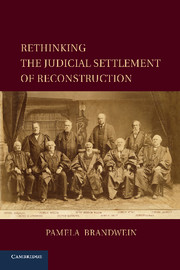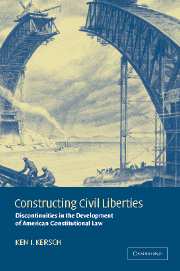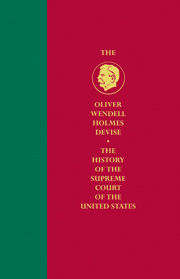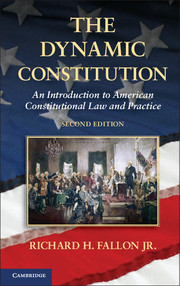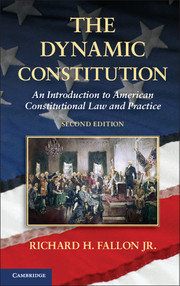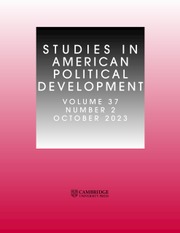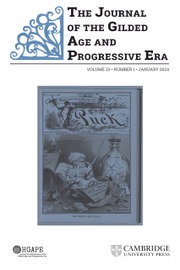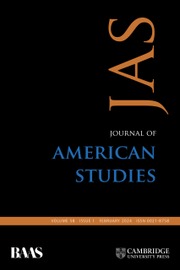Rethinking the Judicial Settlement of Reconstruction
American constitutional lawyers and legal historians routinely assert that the Supreme Court's state action doctrine halted Reconstruction in its tracks. But it didn't.
Rethinking the Judicial Settlement of Reconstruction demolishes the conventional wisdom – and puts a constructive alternative in its place. Pamela Brandwein unveils a lost jurisprudence of rights that provided expansive possibilities for protecting blacks' physical safety and electoral participation, even as it left public accommodation rights undefended. She shows that the Supreme Court supported a Republican coalition and left open ample room for executive and legislative action. Blacks were abandoned, but by the president and Congress, not the Court. Brandwein unites close legal reading of judicial opinions (some hitherto unknown), sustained historical work, the study of political institutions, and the sociology of knowledge. This book explodes tired old debates and will provoke new ones.
- The book offers the first fully developed challenge to standard legal and historical wisdom about 'state action' doctrine
- It shows that an understanding of the Supreme Court's role in American politics depends on investigations of the discursive and institutional contexts in which legal concepts are shaped, debated, and deployed
- It uses an historical case study to overcome the formalist-realist divide in legal studies, demonstrating that it is false to imagine Court decisions as either high jurisprudence or low politics
Reviews & endorsements
“In a sophisticated analysis of the connection between politics and constitutional law, Professor Brandwein revolutionizes our understanding of the role the federal courts played in defining national power to protect civil and political rights during and after Reconstruction.”
—Michael Les Benedict, Emeritus Professor of History, The Ohio State University
“Everyone knows that the Supreme Court murdered the fourteenth amendment’s promise of racial equality. Everyone knows where the murder was committed: in the Slaughter-House Cases and the Civil Rights Cases. Everyone knows the murder weapons: pinched readings of privileges and immunities and of state action. Well, it turns out what everyone knows is dead wrong. In a calm, methodical, and absolutely devastating account, Brandwein shows that in fact the Supreme Court left plenty of room for Congress to act—and Congress faltered. And she offers a compelling whodunit of her own: the tale of how we came to badly misunderstand Reconstruction jurisprudence. This boldly revisionist book opens up dramatic new vistas on American political development and today's constitutional law. It's indispensable—and a great read, too.”
—Don Herzog, University of Michigan
“Pamela Brandwein is one of the most interesting—and meticulous—students of the Supreme Court’s response to Reconstruction. Her close analyses of leading cases have led her to offer an important new reading of that response that makes the Court less complicit in the oppression of African Americans than suggested by the now conventional wisdom. Anyone interested in the legal history of this period must attend to her argument.”
—Sanford Levinson, University of Texas Law School
“This is the best law and politics treatment of the Reconstruction era and its long and dramatic aftermath that has ever been written. Brandwein’s monumental achievement rests on a subtle application and revision of how political scientists think about the role of the Supreme Court in politics. It also offers a model of how to do legal history, based on meticulous and deep primary research and a sustained effort to think about how judges and justices applied the Civil War Amendments and their enforcement statutes. Brandwein takes us deeper into the conceptual and legal world of the Reconstruction and post-Reconstruction rights revolution than anyone has ever taken us — and she thereby forces us to rethink the development of civil and voting rights law in the 20th century. Remarkably, the Reconstruction and post-Reconstruction rights revolution collapsed and disappeared, leaving few conceptual legacies; our contemporary voting and civil rights jurisprudence is fundamentally different. This brilliant study will change how we think about American political and constitutional development.”
—Rick Valelly, Swarthmore College
Product details
March 2014Paperback
9781107625914
282 pages
234 × 156 × 16 mm
0.44kg
Available
Table of Contents
- 1. Introduction
- 2. The emergence of the concept of state neglect, 1867–73
- 3. The civil/social distinction: an intramural Republican debate
- 4. The birth of state action doctrine, 1874–6
- 5. A surviving sectional context, 1876–91
- 6. The Civil Rights Cases and the language of state neglect
- 7. Definitive judicial abandonment and residual expressions, 1896–1909
- 8. A loss of context: the rise of distorted knowledge about state action doctrine
- 9. Conclusion.

